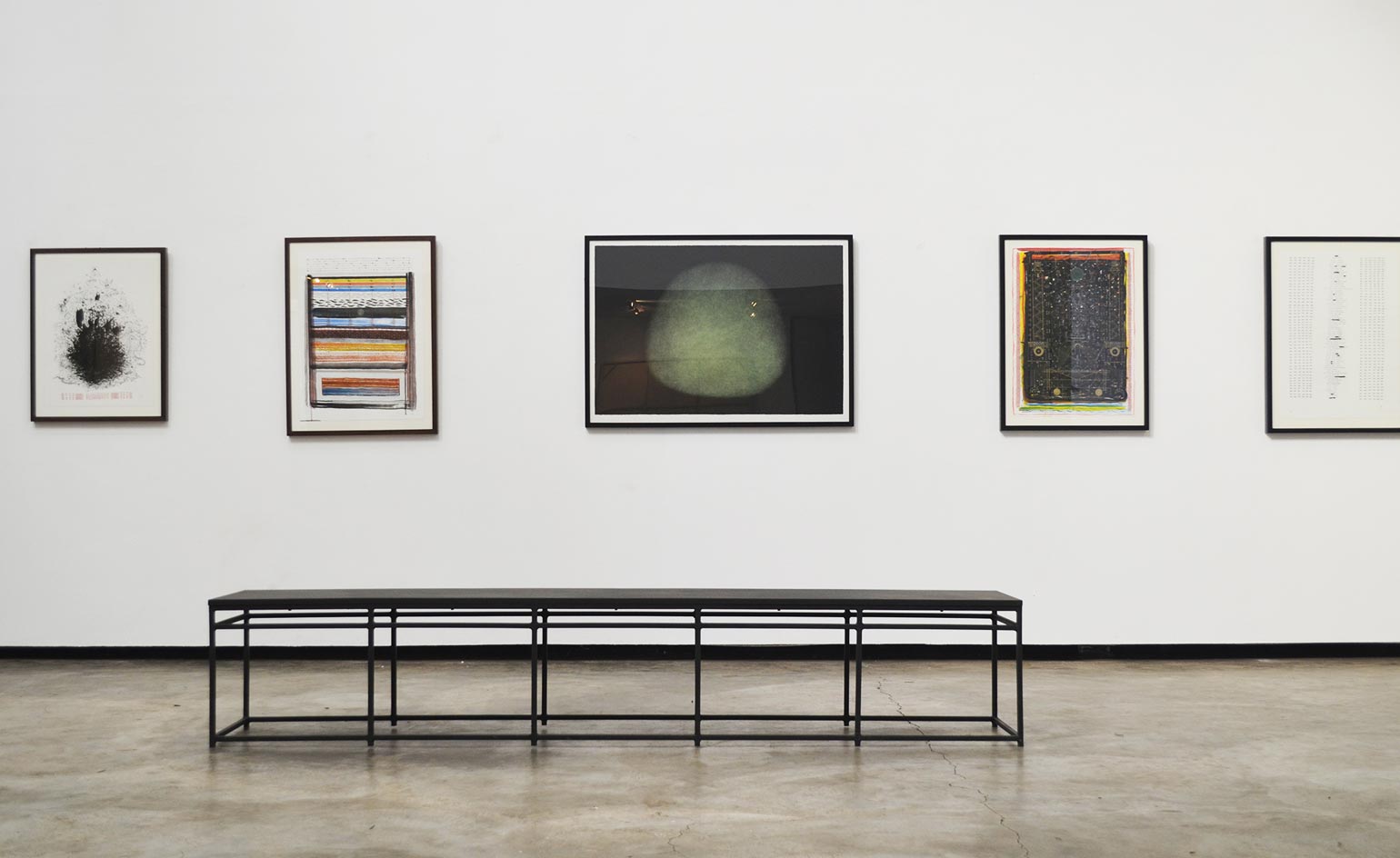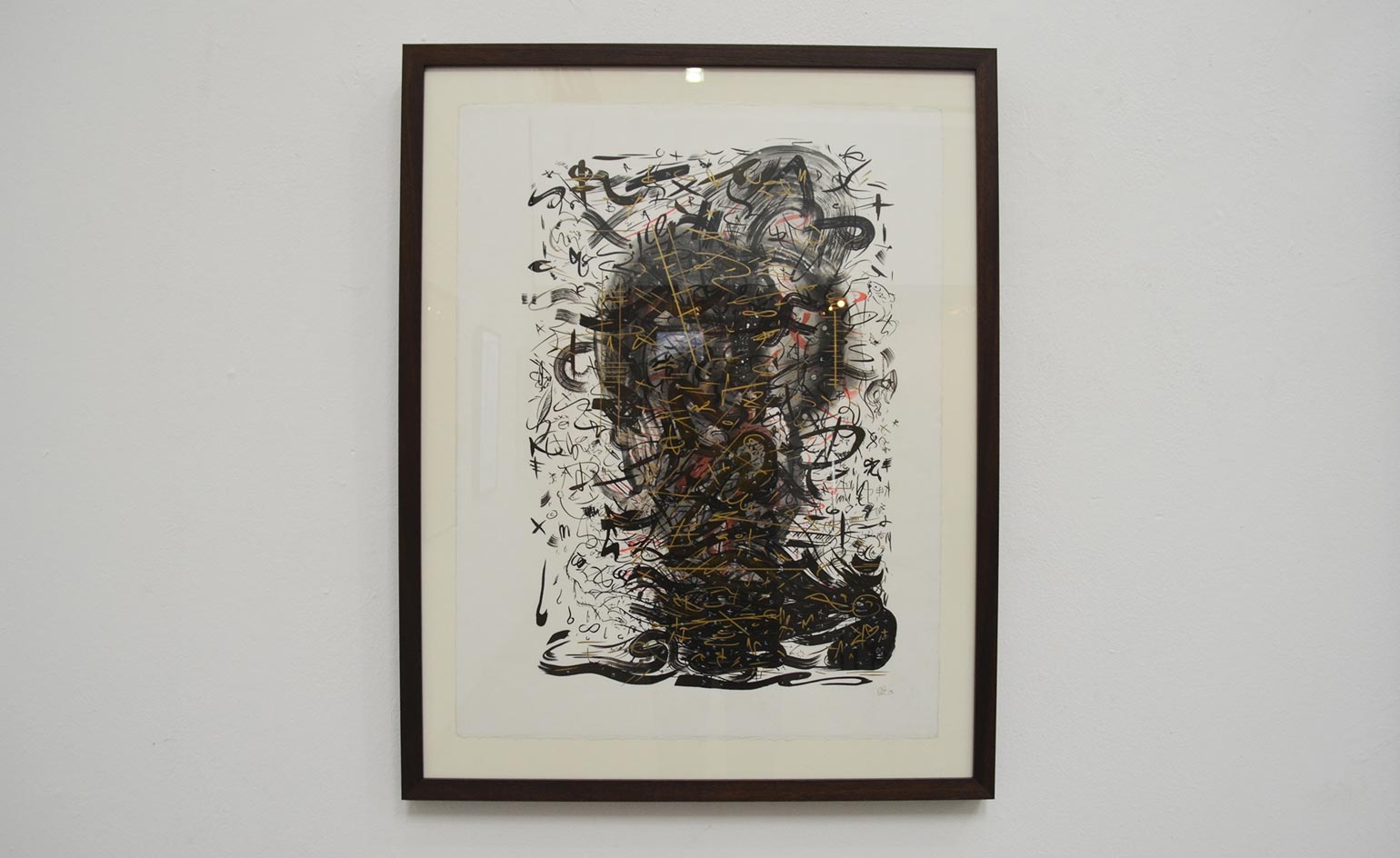Solving the problem: Frederick Clarke's exhibition of language and symbols on show at Johannesburg's Hazard gallery

Firing up Johannesburg's creative scene in May of this year was the opening of a new gallery, Hazard. The space is an offshoot of the Nirox Foundation – a sculpture park and creative hub for contemporary artists in the South African city; in contrast to the natural envrions of Nirox, Hazard is a hip warehouse space in the inner city area of Maboneng that recently revealed a new exhibition of codes and chaos called 'Let X Be' by Frederick Clarke.
Clarke's exhibition explores the complex connections between mathematics, philosophy, science and religion. His works jumble language and symbols into patterns, making them, in his mind, a 'counter element of play and chaos'. The pieces are the result of the automatic writing – filling pages with the essence of his subconscious – that Clarke became interested in while travelling in 2013, and which he began generating in earnest for the show in January of this year.
The 'X' of the show title works as the start and end point for Clarke's vision. As in mathematics, X is what we are constantly trying to work out: the result of the equation. Clarke's work argues that it is an 'insolvable and infinite question', as in the philosophical 'chicken or egg?' debate (and all manner of hypothetical religious wonderings). 'Like any binary, you can't have one without the other,' Clarke explains. 'It is like a game.'
The concepts of play and game are like processes in his work; Afterthoughts appears as a complex calculation over an image of the back of a head. Whilst the piece looks like a set of erratic equations, the 'game' notion comes to mind through its 'ladders' of yellow lines – are they leading to the 'truth'? An answer? 'Not knowing what comes next keeps the process exciting,' Clarke says. So we continue to play.
Science is frequently referenced in Cataract. The piece shows lines of pattern in grey and black tones covering a small illuminated red section. Much like the medical eye condition, the area appears to need to be uncovered. Clarke says his work is 'inspired by DNA and the idea of a program that mutates and adapts over time'. The helix-style pattern here reflects this, posing questions – as with philosophy – without an obvious end.
But those questions remain: what do these pieces mean? Should we dig deeper for an answer? Perhaps we should just embrace Clarke's message and 'Let X Be'.

Clarke's works feature language and symbols jumbled together to evoke the complex connection between mathematics, philosophy, science and religion

The works are derived from the automatic writing that Clarke became interested in while travelling in 2013; the intense writing that has led to this show began in January. Pictured: Drums & Horns

Clarke's piece Afterthoughts appears as a constant calculation over an image seemingly of the back of a head. While the work looks like an erratic sum, the yellow 'ladders' are also reminiscent of a boardgame. Photography courtesy of the artist

Are the ladders leading to the truth? 'Not knowing what comes next keeps the process exciting,' Clarke says. Pictured: Afterthoughts. Photography courtesy of the artist

References to science appear in Cataract – the piece shows lines of pattern in grey and black tones, covering a small illuminated red section. As with the titular condition, the area yearns to be uncovered. Photography courtesy of the artist

Clarke says that his work is 'inspired by DNA and the idea of a program that mutates and adapts over time'

The 'X' of the show's title works as the start and end point for Clarke's vision, as it represents an 'insolvable and infinite question
ADDRESS
Hazard
64 Fox Street, cnr of Main and Berea
Arts on Main
Maboneng Precinct
Johannesburg CBD
Wallpaper* Newsletter
Receive our daily digest of inspiration, escapism and design stories from around the world direct to your inbox.
Sujata Burman is a writer and editor based in London, specialising in design and culture. She was Digital Design Editor at Wallpaper* before moving to her current role of Head of Content at London Design Festival and London Design Biennale where she is expanding the content offering of the showcases. Over the past decade, Sujata has written for global design and culture publications, and has been a speaker, moderator and judge for institutions and brands including RIBA, D&AD, Design Museum and Design Miami/. In 2019, she co-authored her first book, An Opinionated Guide to London Architecture, published by Hoxton Mini Press, which was driven by her aim to make the fields of design and architecture accessible to wider audiences.
-
 Put these emerging artists on your radar
Put these emerging artists on your radarThis crop of six new talents is poised to shake up the art world. Get to know them now
By Tianna Williams
-
 Dining at Pyrá feels like a Mediterranean kiss on both cheeks
Dining at Pyrá feels like a Mediterranean kiss on both cheeksDesigned by House of Dré, this Lonsdale Road addition dishes up an enticing fusion of Greek and Spanish cooking
By Sofia de la Cruz
-
 Creased, crumpled: S/S 2025 menswear is about clothes that have ‘lived a life’
Creased, crumpled: S/S 2025 menswear is about clothes that have ‘lived a life’The S/S 2025 menswear collections see designers embrace the creased and the crumpled, conjuring a mood of laidback languor that ran through the season – captured here by photographer Steve Harnacke and stylist Nicola Neri for Wallpaper*
By Jack Moss